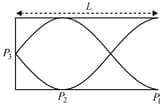EASY
Earn 100
Draw a diagram of standing wave formed inside the organ pipe with both ends closed for first harmonic.
Important Questions on Waves
EASY
MEDIUM
MEDIUM
MEDIUM
A closed organ pipe of length and an open organ pipe contain gases of densities and respectively. The compressibility of gases are equal in both the pipes. Both the pipes are vibrating in their first overtone with same frequency. The length of the open pipe is , where is _______.
(Round off to the Nearest Integer)
EASY
EASY
MEDIUM
HARD
How are stationary waves formed in closed pipes? Explain various modes of vibrations and obtain relations for their frequencies.
A closed organ pipe long is sounded. If the velocity of sound is , what is the fundamental frequency of vibrations of the air column?
MEDIUM
HARD
MEDIUM
EASY
HARD
MEDIUM
HARD
MEDIUM
EASY
A tuning fork is used to set up a wave in a pipe of length closed at one end (see figure).

Then,
MEDIUM
HARD
MEDIUM

